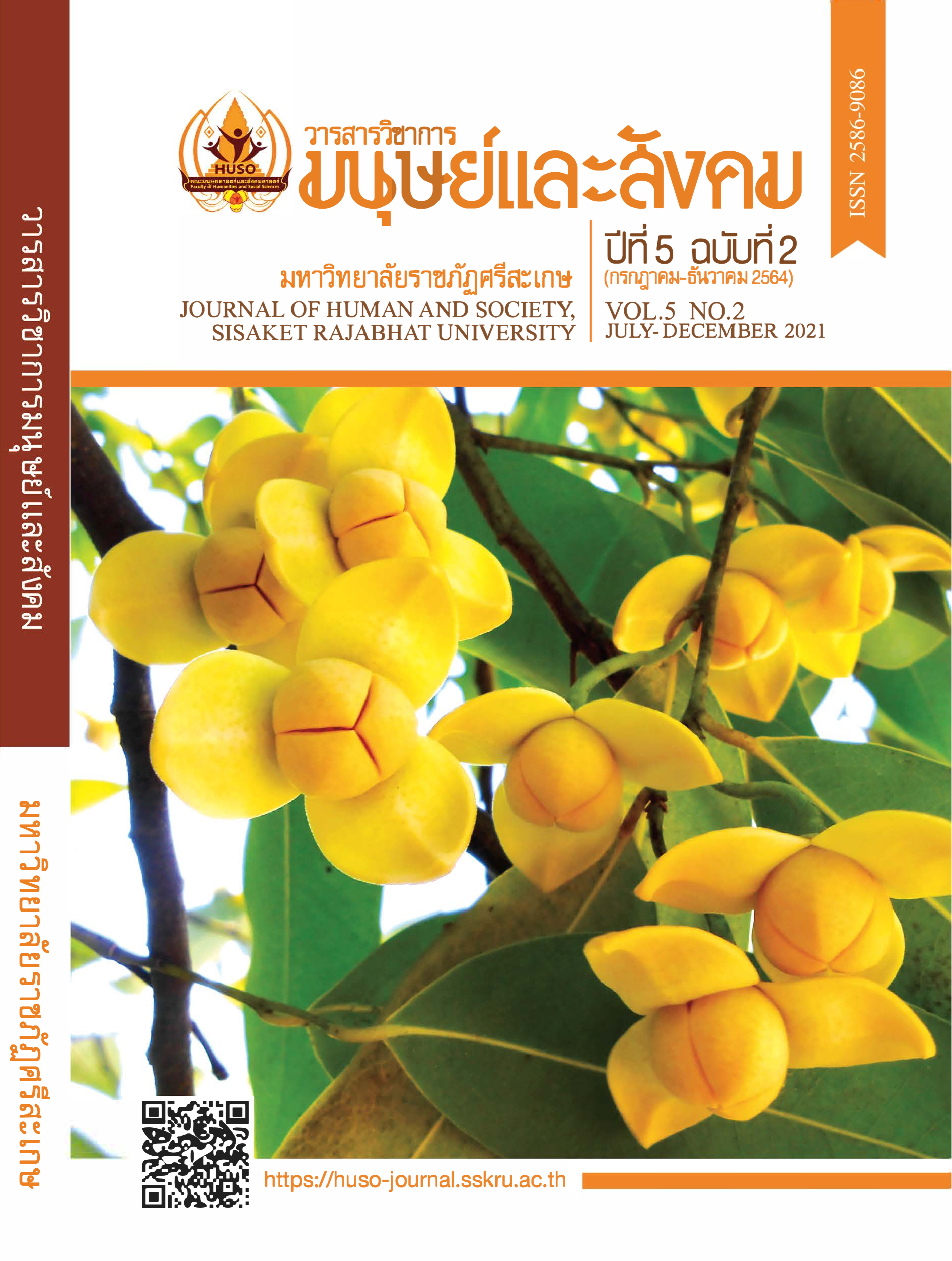Nursing Assistants’ Perspectives on Their Job Characteristics, Workload, and Wage: A Case Study of a Private Hospital in Bangkok
คำสำคัญ:
Bangkok, Nursing Assistants, Job Characteristics, Wage, Private Hospitalบทคัดย่อ
การศึกษาครั้งนี้มีวัตถุประสงค์เพื่อ 1) ศึกษาสาเหตุที่ผู้ช่วยพยาบาลหญิง ในโรงพยาบาลเอกชน จังหวัดกรุงเทพมหานคร เลือกทำงานอาชีพผู้ช่วยพยาบาลที่มีรายได้ต่ำ 2) ศึกษาสาเหตุที่อยู่ในอาชีพปัจจุบันมาเป็นระยะเวลาหลายปี และ 3) เพื่อค้นหาแผนการในอนาคตของผู้ช่วยพยาบาลใน 5 ปีข้างหน้า งานวิจัยชิ้นนี้ใช้การสัมภาษณ์ชนิด กึ่งโครงสร้างกับผู้ช่วยพยาบาลจำนวน 20 คน จากแผนกผู้ป่วยนอกของศูนย์โรคเบาหวานและศูนย์ตรวจโรคทั่วไป ผลการศึกษาพบว่า ผู้ช่วยพยาบาลส่วนใหญ่เลือกทำงานในอาชีพผู้ช่วยพยาบาลเนื่องมาจากข้อจำกัดทางการเงินของพ่อแม่ นอกจากนี้ ข้อจำกัดทางสถาบันจากระบบการศึกษาของประเทศไทยเป็นอุปสรรคที่ทำให้ผู้ช่วยพยาบาลไม่สามารถเข้าศึกษาต่อในระดับปริญญาตรีในมหาวิทยาลัยของรัฐ จากข้อจำกัดเหล่านี้ ทำให้ผู้ช่วยพยาบาลได้ ลงเรียนหลักสูตรผู้ช่วยพยาบาลเป็นระยะเวลา 6 เดือน ซึ่งเป็นการลงทุนมนุษย์ต้นทุนต่ำ นอกจากนี้ สาเหตุหลักที่ผู้ช่วยพยาบาลส่วนใหญ่ทำงานในอาชีพปัจจุบันมาเป็นระยะเวลาหลายปี เนื่องมาจากข้อจำกัดทางการเงินและสาเหตุอื่น ๆ เช่น ค่าทำงานล่วงเวลา ความมั่นคงของงานจากการขึ้นเงินเดือนทุกปี ความพึงพอใจทางสังคมในสถานที่ทำงาน สวัสดิการของโรงพยาบาล และการพัฒนาสายความก้าวหน้าในงาน สำหรับแผนการอนาคตใน 5 ปีข้างหน้า ผู้ช่วยพยาบาลบางคนต้องการที่จะเป็นพยาบาลวิชาชีพที่ได้รับใบอนุญาต ขณะที่ผู้ช่วยพยาบาลที่มีบุตรต้องการที่ย้ายกลับไปยังภูมิลำเนาของตนเพื่อดูแลบุตรและพ่อแม่ และต้องการทำธุรกิจเล็ก ๆ เช่น ร้านขายของชำ และร้านอาหาร
เอกสารอ้างอิง
Anker, R. (1998). Gender and Jobs: Sex Segregation of Occupations in the World. International Labor Organization.
Aoki, M., Keiwkarnka, B., & Chompikul, J. (2011). Job Stress among Nurses in Public Hospitals in Ratchaburi Province, Thailand. Journal of Public Health and Development, 9(1), 19-27.
Asian Development Bank. (2020). Country Diagnostic Study on Long-Term Care in Thailand. ADB Publications.
Bangkok Inter Care School. (2021, May 1). Nursing Assistant Program. https://www.bkk-intercare.com
Barnett, R.C., & Gareis, K.C. (2002). Full-time and reduced-hour work schedules and marital quality. Work and Occupations, 29(3), 364- 379. http://doi:10.1177/0730888402029003005.
Boonyoung, N. (2010). Nursing Strategic Planning. Thai Journal of Nursing Council, 25(2), 18-26.
Bryman, A. (2001). Social Research Methods. Oxford University Press.
Bryman, A. (2012). Social Research Methods (4th ed.). Oxford: University Press.
Cresswell, J. (2007). Qualitative Inquiry and Research Design: Choosing among Five Approaches. SAGE.
Crompton, R., & Harris, F. (1998). Explaining women’s employment patterns: ‘orientations to work’ revisited. The British Journal of Sociology, 49(1), 118-136. http://doi:10.2307/591266.
Denscombe, M. (2010). The Good Research Guide for Small-Scale Social Research Projects (4th ed.). McGraw Hill.
Dex, S., & Joshi, H. (1999). Careers and motherhood: Policies for compatibility. Cambridge Journal of Economics, 23(5), 641-659. http://doi:10.1093/cje/23.5.641.
Fagan, C., & Burchell, B. (2002). Gender, Jobs and Working Conditions in the European Union. Dublin: European Foundation for the Improvement of Living and Working Conditions.
Gillham, B. (2000). Case Study Research Methods. Continuum.
Glover, J. (2002). The “Balance Model”: Theorising Women’s Employment Behavior. In: Carling, A., Duncan, S. & Edwards, R., eds. Analysing Families: Morality and Rationality in Policy and Practice. Routledge, Ch. 13.
Gregory, A., & Milner, S. (2009). Editorial: work-life balance: A matter of choice? Gender, Work and Organization, 16(1), 1-13. http://doi:10.1111/j.1468-0432.2008.00429.x.
Gregory, A., & Windebank, J. (2000). Women’s Work in Britain and France: Practice, Theory and Policy. Macmillan Press Limited.
Hakim, C. (1991). Grateful slaves and self-made women: Fact and fantasy in women’s work orientations. European Sociological Review, 7(2), 101-121. http://doi:10.1093/oxfordjournals.esr.a036590.
Hakim, C. (1995). Five feminist myths about women’s employment. The British Journal of Sociology, 46(3), 429-455. http://doi:10.2307/591850.
Hakim, C.(1996). Key Issues in Women’s Work: Female Heterogeneity and the Polarization of Women’s Employment. Athlone Press Limited.
Hakim, C. (2000). Work-Lifestyle Choices in the 21st Century: Preference Theory. Oxford University Press.
Jonung, C. (1998). Occupational Segregation by Sex and Change over Time. In: Persson, I. and Jonung, C., eds. Women’s Work and Wages. Routledge, Ch.2.
Kemp, A. (1994). Women’s Work: Degraded and Devalued. New Jersey: Prentice Hall.
Khorpetch, C., & Kulkolkarn, K. (2011). Gender Wage Discrimination in the Thai Labor Market. Applied Economics Journal, 18(2), 17-31.
Kim, M. (2000). Women paid low wages: Who they are and where they work. Monthly Labor Review, 123(9), 26-30. http://doi:10.2307/41845234.
Kirton, G., & Greene, A. (2005). The Dynamics of Managing Diversity: A Critical Approach (2nd ed.). Oxford and Burlington: Elsevier Butterworth-Heinemann.
Marshall, C., & Rossman, G. (1995). Designing Qualitative Research. SAGE.
May, T. (1997). Social Research: Issues, Methods and Process. Open University Press.
Mayo, A. (2016). Human Resources or Human Capital: Managing People as Assets. Routledge.
Olaniyan, D.A., & Okemakinde, T. (2008, June 1). Human Capital Theory: Implications for Educational Development. European Journal of Scientific Research, 24(2), 157-162. http://medwelljournals.com/abstract/?doi=pjssci.2008.479.483
Patton, M.Q. (2002). Qualitative Research and Evaluation Methods(3rd ed.). SAGE.
Presser, H.B. (1994). Employment schedules among dual-earner spouses and the division of household labor by gender. American Sociological Review, 59(3), 348-364. http://doi:10.2307/2095938.
Pujol, M. (1995). Into the Margin. In: Sap, K., Sap, J., Feiner, S., Ott, N. and Tzannatos, Z., eds. Out of the Margin: Feminist Perspectives on Economics. Routledge, Ch.1.
Rubin, H., & Rubin, I. (2005). Qualitative Interviewing: The Art of Hearing Data (2nd ed.). SAGE.
Thi Bui, M., & Permpoonwiwat, C. (2015). Gender wage inequality in Thailand: A sectoral perspective. International Journal of Behavioral Science, 10(2), 19-36. http://doi:10.14456/ijbs.2015.40
Warren, T., Fox, E., & Pascall, G. (2009). Innovative social policies: Implications for work-life balance among low-waged women in England. Gender, Work and Organization, 16(1), 126-150. http://doi:10.1111/j.1468-0432.2008.00433.x.
Warren, T., & Walters, P. (1998). Appraising a dichotomy: A review of ‘part- time/fulltime’ in the study of women’s employment in Britain. Gender, Work and Organization, 5(2), 102-118. http://doi:10.1111/1468-0432.00049.
Xiao, J. (2001). Determinants of Salary Growth in Shenzhen, China: An Analysis of Formal Education, On-the-Job Training, and Adult Education with a Three-Level Model. The Chinese University of Hong Kong, Faculty of Education.
ดาวน์โหลด
เผยแพร่แล้ว
รูปแบบการอ้างอิง
ฉบับ
ประเภทบทความ
สัญญาอนุญาต

อนุญาตภายใต้เงื่อนไข Creative Commons Attribution-NonCommercial-NoDerivatives 4.0 International License.







